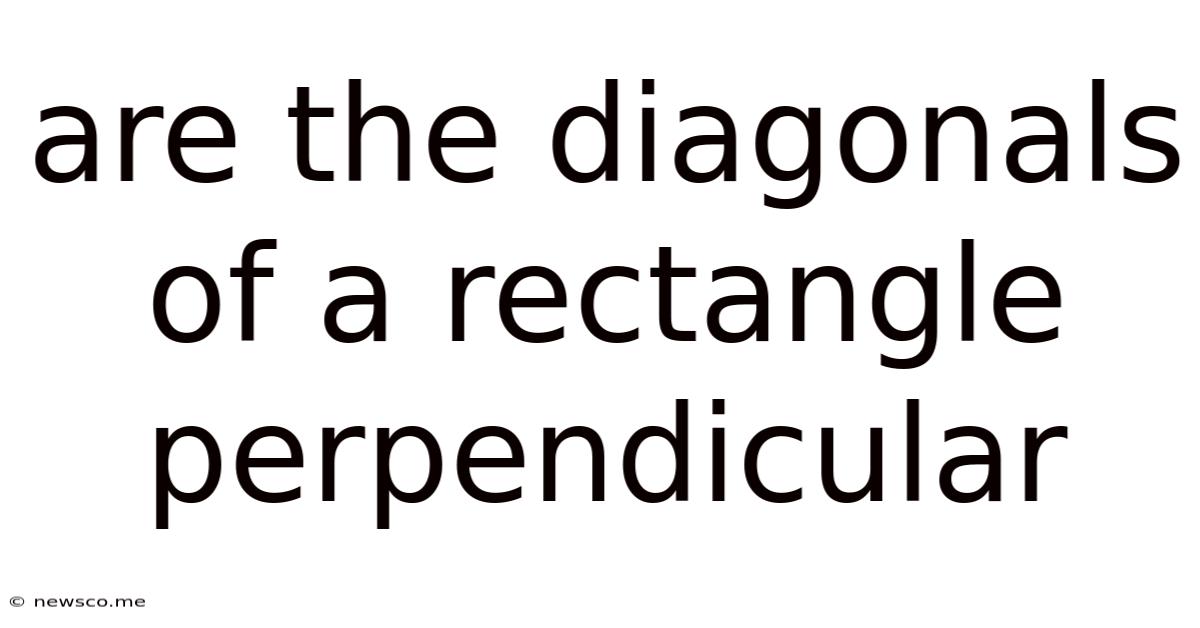Are The Diagonals Of A Rectangle Perpendicular
News Co
Apr 19, 2025 · 4 min read

Table of Contents
Are the Diagonals of a Rectangle Perpendicular? Exploring Geometric Properties
The question, "Are the diagonals of a rectangle perpendicular?" is a fundamental one in geometry, leading us into a deeper exploration of the properties of rectangles and their diagonals. The short answer is: no, the diagonals of a rectangle are not perpendicular, except in a special case. This article will delve into the reasons why, exploring the geometric principles involved and showcasing how this property differs from other quadrilaterals. We'll examine various proofs, discuss related concepts, and provide examples to solidify your understanding.
Understanding Rectangles and Their Properties
Before addressing the perpendicularity of diagonals, let's establish a firm foundation in the definition and properties of rectangles. A rectangle is a quadrilateral—a closed, two-dimensional shape with four sides—possessing several key characteristics:
- Four right angles: Each interior angle of a rectangle measures 90 degrees. This is a defining feature distinguishing it from other quadrilaterals like parallelograms or trapezoids.
- Opposite sides are parallel and equal in length: This ensures the rectangle's stability and symmetry. Parallel sides mean they never intersect, no matter how far they extend. Equal lengths maintain the rectangular shape.
- Diagonals bisect each other: The diagonals of a rectangle intersect at their midpoints. This means each diagonal cuts the other precisely in half.
Why the Diagonals Aren't Perpendicular (Generally)
The diagonals of a rectangle are only perpendicular under specific circumstances. In a general rectangle, the diagonals intersect but do not form right angles. To understand this, consider the following:
Visualizing the Non-Perpendicularity
Imagine a typical rectangle—longer than it is wide. Draw its diagonals. You'll see they intersect, creating four triangles. However, the angles formed at the intersection point are clearly not 90 degrees. The diagonals create acute and obtuse angles, not right angles.
Proof Through Coordinate Geometry
Let's use coordinate geometry to demonstrate this. Consider a rectangle with vertices at (0,0), (a,0), (a,b), and (0,b), where 'a' and 'b' represent the lengths of the sides.
- Diagonal 1: Connects (0,0) and (a,b). Its slope (m1) is b/a.
- Diagonal 2: Connects (0,b) and (a,0). Its slope (m2) is -b/a.
For two lines to be perpendicular, the product of their slopes must equal -1. In this case:
m1 * m2 = (b/a) * (-b/a) = -b²/a²
This only equals -1 if b = a.
The Special Case: The Square
The exception to this rule lies in the square. A square is a special type of rectangle where all four sides are equal in length. In a square:
- The diagonals are perpendicular: The intersection of the diagonals forms four right angles, dividing the square into four congruent right-angled isosceles triangles.
This is because the slopes of the diagonals in a square (where a=b) satisfy the perpendicularity condition: -b²/a² = -1.
Proof for Squares
The proof for the perpendicularity of diagonals in a square can be approached geometrically:
-
Congruent Triangles: Consider the four triangles formed by the diagonals. Due to the square's properties (equal sides and right angles), these triangles are congruent by the Side-Angle-Side (SAS) congruence postulate.
-
Equal Angles: Since the triangles are congruent, their corresponding angles are equal. The angles at the intersection of the diagonals are all equal.
-
Sum of Angles: The angles around the intersection point sum to 360 degrees. Because they are equal, each angle must be 360/4 = 90 degrees.
Therefore, the diagonals of a square are perpendicular.
Exploring Related Concepts
Understanding the perpendicularity (or lack thereof) of diagonals in rectangles connects to several other geometric concepts:
-
Parallelograms: Rectangles are a special case of parallelograms. While the diagonals of a parallelogram bisect each other, they are not necessarily perpendicular, except in the specific case of a rhombus or square.
-
Rhombuses: A rhombus is a parallelogram with four equal sides. Its diagonals are perpendicular bisectors of each other.
-
Isosceles Triangles: The diagonals of a rectangle divide it into four triangles. In the case of a square, these are congruent isosceles right-angled triangles.
Practical Applications and Real-World Examples
The properties of rectangles and their diagonals have numerous applications in various fields:
-
Architecture and Construction: Understanding rectangular geometry is crucial in building design and structural engineering. The stability and properties of rectangles are essential for constructing buildings and other structures.
-
Computer Graphics: Rectangles and squares form the basis of many graphics and image manipulation techniques.
-
Cartography: Rectangular coordinate systems are frequently used in mapping and geographical information systems.
Conclusion: The Distinctive Nature of Rectangular Diagonals
In summary, the diagonals of a rectangle are not generally perpendicular. This property is a distinguishing feature of rectangles compared to squares and other quadrilaterals. The only time the diagonals of a rectangle are perpendicular is when the rectangle is also a square – a special case where all sides are equal in length. Understanding this difference is fundamental to grasping the unique geometric characteristics of rectangles and their relationship to other shapes within the broader context of geometry. This knowledge is vital for various practical applications across numerous disciplines. Through rigorous proofs and visual examples, we’ve explored this concept, enhancing your understanding of geometric principles and their practical implications.
Latest Posts
Related Post
Thank you for visiting our website which covers about Are The Diagonals Of A Rectangle Perpendicular . We hope the information provided has been useful to you. Feel free to contact us if you have any questions or need further assistance. See you next time and don't miss to bookmark.